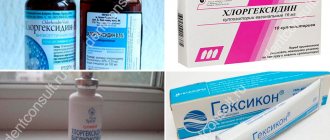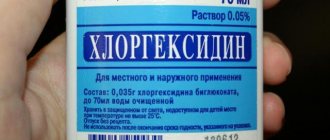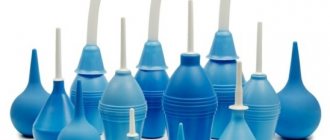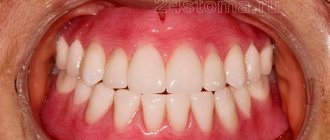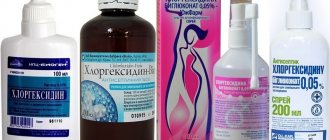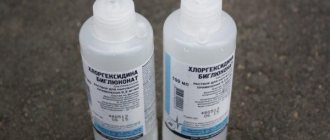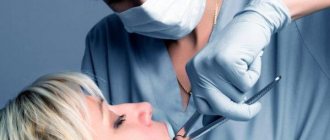Humans are part of living nature; they are constantly surrounded by multibillion-strong communities of bacteria and viruses that can cause serious diseases. For treatment, pharmacists offer a variety of medications that can lead to complications, so a possible allergy to Miramistin raises many questions. This drug, like Chlorhexidine, is prescribed by doctors for a number of diseases.
Characteristics of Chlorhexidine
Chlorhexidine bigluconate is a drug with a pronounced antimicrobial, antiseptic and disinfectant effect. It is actively used in dentistry, gynecology, otolaryngology, dermatology, and urology. It is quite possible to be poisoned by Chlorhexidine, but not with the kind sold in pharmacies. This is a 0.05% aqueous solution, transparent, without a specific smell or taste. This Chlorhexidine is capable of killing bacteria on the skin and mucous membranes, and when taken orally it causes only mild signs of poisoning. Another thing is a 20% alcohol dilution, intended for the needs of medical departments. It is diluted locally to 0.5%, 1%, 5% for antiseptic wiping of surfaces and disinfection of instruments.
If a 20% solution of Chlorhexidine is swallowed, a severe burn of the mucous membranes of the gastrointestinal tract, incompatible with life, is possible.
Characteristics of the drug and its properties
Chlorhexidine is an antiseptic with pronounced bactericidal properties, successfully used in medicine for more than 50 years. Has an active effect against protozoa, herpes and bacteria.
The substance can be released in the form:
- externally applied solution – 0.05% or 20%;
- gel;
- ointments;
- spray;
- candles.
The solutions are packaged in glass or polymer bottles with a volume of 100 ml or 500 ml. This is very convenient, since the polymer bottles are equipped with a cap, and in case of wounds or cuts outside the home, you can wash your hands with the drug directly from the bottle.
Chlorhexidine is used as:
- care after surgery;
- treatment of ulcers and burns;
- treatment of wounds, cracks and abrasions of the skin and mucous membranes;
- combating fungal and bacterial infections of the skin and mucous membranes;
- prophylactic agent in obstetrics and gynecology, urology;
- prevention of STDs;
- skin disinfectants;
- preparation for the treatment of dentures;
- substances for sanitation before diagnosis and treatment;
- means for sterilizing medical instruments;
- disinfectant for thermometers and surfaces;
- a preparation for treating the surgeon’s hands, the surgical field and the patient’s skin;
- means for the production of glycerin, alcohol or aqueous concentrates.
You can even gargle with the solution if you have a cold.
Thus, we see that chlorhexidine is widely used in obstetrics and gynecology, urology, dentistry, in the practice of otolaryngology and in surgical operations.
Symptoms of chlorhexidine poisoning occur when the substance enters the body
Drug interactions
- Concomitant use with iodine is not recommended.
- Chlorhexidine is incompatible with detergents containing anionic group (saponins, sodium lauryl sulfate, sulfonic acid, sodium carboxymethylcellulose) and soaps. The presence of soap can inactivate chlorhexidine, so before using the drug, any remaining soap must be thoroughly rinsed off.
- Forms a toxic compound when mixed with sodium hypochlorite (NaOCl) - para-chloroaniline ( p
-NH3C6H4Cl).
Parachloroaniline is reported to be toxic (Chhabra et al., 1991; Burkhardt-Holm et al., 1999) [ incomplete references
] and can cause the formation of methemoglobin (Chhabra et al., 1991). [
incomplete reference
] - Ethanol enhances the effectiveness of chlorhexidine.
Causes of drug poisoning
Taking Chlorhexidine solution orally is strictly prohibited, but this method of use is used with alarming regularity. And it's not about suicide attempts at all. Fans of healthy lifestyle practice the method of treating various diseases in such an original and very dangerous way. It is not surprising that due to damage to the mucous membranes, pathologies that were previously mild in severity begin to progress and often recur.
Poisoning can also occur due to carelessness. This drug is often prescribed to treat the throat in the treatment of respiratory infections along with cough syrups and antibiotic suspensions. If you feel unwell, it is quite possible to mix up the bottles.
A 20% alcohol solution of Chlorhexidine can be converted into vapor. In a confined space, inhaling them can lead to severe intoxication.
Description
In Soviet times, this drug was almost unknown in our country, while in the West it has been used for a long time. It was opened in Great Britain in the early 1950s. However, data on its high effectiveness and safety did not appear immediately. At first, the drug was treated with caution, since it was unknown what side effects its use could lead to. And only after they were not found did its widespread use begin.
Chlorhexidine is a universal, broad-spectrum bactericidal agent. There are few bacteria that can resist it. In addition, the drug is active against many fungi and even against some viruses, such as the herpes virus.
From a chemical point of view, the drug belongs to chlorine-containing biguanide derivatives. In finished dosage forms, chlorhexidine is contained in the form of bigluconate. The principle of action of the drug is based on its interaction with the membranes of bacterial cells. Chlorhexidine reacts with phosphate groups on the surface of membranes, which leads to disruption of osmotic balance and subsequent destruction of the membrane, as a result of which microorganisms die. Those fungi and viruses that, like bacteria, have lipid membranes, can also be affected by the drug. Although in this respect the drug is still inferior to antifungal and antiviral agents.
The drug is active against both gram-positive and gram-negative bacteria. It is characteristic that bacteria have not yet been able to develop resistance to the drug. Chlorhexidine is weakly active only against some strains of pseudomonas, bacteria of the genus Proteus, and bacterial spores. Fungal spores are resistant to chlorhexidine. The drug weakly affects the vital activity of lactobacilli.
Chlorhexidine Bigluconate
In Russia, Chlorhexidine, available to consumers, is produced only in the form of bigluconate . Therefore, this object under consideration should be considered a full-fledged antiseptic drug that is sold in pharmacies. It is widely used in gargling and mouthwash for gum inflammation. It is also effective in the treatment of fungal diseases, before some gynecological and proctological examinations. 500 ml bottle . An important advantage of this medication is the absence of a systemic effect on the human body. The fact is that the product does not penetrate the circulatory system and is not absorbed. But upon contact with unwanted microorganisms, the active properties of this substance do not disappear.
Symptoms of Chlorhexidine poisoning
Taking a concentrated alcohol solution is much more difficult for the body to tolerate than an aqueous solution. The main signs of such poisoning:
- attacks of nausea and vomiting;
- pain in the throat, epigastric region and abdomen, heartburn, sour belching;
- diarrhea or constipation;
- impaired coordination of movements;
- migraine-like headaches;
- tremor of the limbs, turning into convulsions;
- facial redness;
- drop in blood pressure;
- thready pulse.
When inhaling vapors, shortness of breath, a feeling of lack of air when inhaling, redness of the eyes, and dryness of the nasal mucosa occur. If first aid is not provided, the victim loses consciousness.
Use of the drug and signs of poisoning
The drug is used in different ways, however, despite its high safety, the likelihood of poisoning occurs only when gargling or gargling. This most often occurs when chlorhexidine is accidentally ingested.
As a result, the following symptoms may occur:
attacks of nausea and vomiting;
discomfort in the stomach;
a feeling of “tearing” in the throat - a consequence of a burn to the mucous membrane;
temperature increase to 37-38 C;
headache;
feeling of lethargy and chills;
increased sweating.
The effect of chlorhexidine on the body is strictly individual. In some cases, short-term loss of consciousness or increased excitability is possible; quite rarely, poisoning is accompanied by diarrhea.
Important! The drug is contraindicated for use in case of individual intolerance, as well as for dermatitis.
In dental and ENT practice, solutions with a concentration of 0.02% or 0.05% are most often used. It is recommended to rinse after eating, after brushing your teeth.
Note! It is not for nothing that the instructions state the importance of rinsing after eating. In case of accidental ingestion of the drug on a “full” stomach, the organ is already covered with food and the solution will not get inside. As a result, the solution reacts with food, and not with the mucous membranes of the gastrointestinal tract, and its concentration in the body decreases.
For one rinse, about 15-20 ml of solution is used, the duration of the procedure is on average 30 seconds. After rinsing for 15-20 minutes, you should not eat food or any liquids, or perform any manipulations in the oral cavity.
Contraindications
Chlorhexidine is far from a harmless medicine. Frequent use leads to drying of the mucous membranes and the appearance of unpleasant sensations in the vagina. This applies to douching and washing. The microflora, altered due to vaginal dryness, may not be able to withstand it, then even more favorable conditions for the spread of candida will be formed in the body.
If you are allergic to the components, burning and redness appear in the groin and labia.
The drug is not prescribed:
- if the patient is under 16 years of age;
- there is a high sensitivity to the components;
- during menstruation (therapeutic value is extremely low).
Douching with Chlorhexidine during pregnancy increases the risk of infection of the fetus.
First aid for Chlorhexidine poisoning
If a person swallows Chlorhexidine while gargling, it is advisable to induce vomiting. To do this, you need to drink warm water or a slightly pink dilution of potassium permanganate, and then press your fingers on the root of the tongue. In case of poisoning, it is strictly forbidden to rinse the stomach after taking a concentrated alcohol solution . When it passes, it will burn the esophagus and mouth, causing serious breathing problems.
In this case, you need to call a doctor, and before he arrives, help the victim:
- give any fast-acting laxative, for example, magnesium sulfate, as well as enterosorbent - Polyphepan, activated carbon, Enterosgel;
- drink hot, sweet tea.
The arriving doctor decides what to do next. He examines an adult or child and, if necessary, hospitalizes him.
For stomach pain that occurs after poisoning, you can give the victim any analgesic (Paracetamol, Analgin). But nonsteroidal anti-inflammatory drugs that stimulate the production of hydrochloric acid by the gastric mucosa are strictly contraindicated.
Side effects
An important feature of the drug is its relatively low toxicity. It has almost no effect on the cells of the human body. However, this, of course, does not mean that the drug is completely harmless. It is still not recommended to use it internally. If this happens, then you should use sorbents, such as activated carbon, and perform gastric lavage. In addition, it can cause burns to mucous membranes. For this reason, chlorhexidine should not be used to treat eye infections such as conjunctivitis. If the drug gets into your eyes, rinse them thoroughly with water. You should also avoid getting the drug on the meninges, for example during open head injuries. It is prohibited to use the drug to treat ear diseases with a damaged eardrum.
Treatment of intoxication
The toxicity of Chlorhexidine is high only at high concentrations. In this case, the victim is hospitalized for further treatment in a hospital. There is no specific antidote that can neutralize the active ingredient, so therapy is aimed at eliminating the symptoms of poisoning.
The following clinical and pharmacological groups are used:
- enterosorbents;
- gastroprotectors;
- hepatoprotectors;
- regeneration stimulants.
For fluid loss with vomiting and diarrhea, treatment regimens include Hydrovit or Regidron. Their use allows you to replenish the reserves of essential macroelements. Severe poisoning requires intravenous administration of solutions of sodium chloride, Ringer, and glucose.
Predisposing factors
The antiseptic in question has been successfully used in medicine for more than fifty years. The development of pathological reactions to it can be explained by the fact that it is made on the basis of a complex of chemical components, therefore there are age restrictions on its use. Allergy to chlorhexidine is a fairly rare phenomenon, but in recent years such cases have become more frequent, and therefore new data have emerged about this drug, indicating its allergenic activity. In many cases, life-threatening pathological symptoms occur in patients in the postoperative period. There are risk factors that contribute to the development of inadequate immune responses to antiseptics:
- Genetic tendency to allergies.
- Presence of bronchial asthma.
- Hypersensitivity to other antiseptics and antibiotics.
- Weakened immunity due to chronic pathologies.
Features of intoxication
If you drink Chlorhexidine in the form of 0.05% aqueous dilution, then, with a high degree of probability, signs of poisoning will arise due to self-hypnosis. Exceptions are children, old people, and weakened patients. An overdose is manifested by nausea, dizziness, mild peristalsis, lack of appetite, and drowsiness.
In children
In pediatrics, Chlorhexidine is used from birth to destroy germs and viruses. It is used to treat diaper rash, abrasions, wounds, cuts, and skin rashes of allergic origin. If 1-2 tablespoons are accidentally swallowed, a slight disturbance of peristalsis is noted. But a concentrated solution of the drug that enters the child’s stomach is poisonous. The famous pediatrician Komarovsky warns parents against self-medication for any poisoning. If Chlorhexidine solution enters the stomach, the child must be immediately taken to the intensive care unit.
During pregnancy and lactation
During the period of bearing a child, Chlorhexidine is prescribed to women for rinsing the throat, treating gums and teeth after visiting the dentist, and for otitis media for instillation in the ear. It quickly destroys pathogenic microorganisms without having a negative effect on the fetus. But during pregnancy, it is dangerous for a woman to come into contact with a 20% alcohol dilution of the drug, including its vapor. Its active substance is able to penetrate biological barriers, including placental ones.
Chlorhexidine
This drug is antiseptic and has a disinfecting effect . It is used during operations to treat instruments, hands, disinfect wounds, and surfaces. On pharmacy shelves you can find the active substance in the form of gels and solutions. This substance exists in several forms. Aqueous and alcohol solutions are used externally. It can be produced in different concentrations and each has its own purpose of use. For example, a 0.05% solution can not be diluted with water and used in its pure form.
Products with a concentration of more than 0.5% are mainly used to treat burns, disinfect the hands of medical personnel and to prevent infection. This substance is present in many medications.
Diagnostics
To accurately determine whether you may be allergic to Miramistin or Chlorhexidine, you must consult a doctor for a laboratory examination. Skin testing is a common way to determine allergies. The patient is given a minimal dose of the irritant and the body’s reaction is observed.
There are a number of contraindications for the procedure:
- infectious diseases;
- presence of HIV infection;
- risk of anaphylactic reaction;
- pregnancy, lactation period;
- asthma;
- malignant neoplasms;
- mental disorders;
- allergies during exacerbation.
Disadvantages include the fact that the analysis can only be carried out during remission. This diagnostic method is used less and less, since the introduction of allergens may lead to complications, especially in children. Laboratory diagnostic methods are used more often.
The allergist prescribes the following examinations:
- determination of total immunoglobulin E;
- histamine and leukotriene tests;
- ELISA for immunoglobulins;
- radiosorbent method for immunoglobulins;
- fluorescent method.
The material for analysis is venous blood. These modern methods allow you to quickly and accurately obtain results; for each patient, the allergist selects an examination regimen individually.
Prevention and precautions
More often, poisoning is diagnosed in children, and not even the smallest ones. If the bottle is left in a visible place, then the child’s curiosity will always prevail over the parent’s prohibition from touching the medicine. Out of curiosity, a baby may swallow a product that does not have an unpleasant taste or odor. The drug should only be stored in a locked box. Poisoning also occurs when taking expired Chlorhexidine. Chemical reactions have already begun to occur in it, increasing its toxicity. It is imperative to monitor the expiration date of the drug.
Treatment with miramistin
Before each use of miramistin, the container in which the solution is located must be shaken.
To get rid of bad breath, an adult irrigates the oral cavity with Miramistin spray 3-4 times a day. For a child, 1 injection up to three times a day will be enough .
In addition to eliminating bad breath, this remedy can treat stomatitis. To do this, mix 5 ml of solution with a glass of warm water and rinse your mouth after each meal.
Keep an eye on the expiration date of the drug.
Indications
Photo: YJPTO/Shutterstock.com
The scope of application of the drug is varied. This is the treatment and treatment of wounds, cuts, pimples, acne, prevention and treatment of sexually transmitted diseases. The drug is widely used for the treatment of diseases of the oral cavity - stomatitis, periodontitis, gingivitis, upper respiratory tract - pharyngitis and tonsillitis, for the treatment of dentures. Also, the drug is often used to disinfect the surgeon’s hands, surgical instruments, the surgical field during operations and other medical procedures, disinfection of medical equipment, thermometers, etc. In addition, the drug is necessary for disinfecting the hands of workers in catering establishments, the food industry and public utilities.
The drug has a high degree of safety. It can be used in childhood and pregnancy. True, since the drug has been used relatively recently compared to most other antiseptics, caution is recommended.
Indications for use
Indications for use of the drug include:
- Carrying out disinfection of wounds of various types, including those on mucous membranes.
- Use as part of complex therapy in the treatment of various fungal infections.
- Preventive treatments to prevent STDs.
- Treatment of oral diseases such as gingivitis, periodontitis and stomatitis.
When treating wounds, cuts, abrasions and other injuries, the solution is applied directly to the surface of the skin and injury without the use of gauze pads or cotton swabs (discs). To carry out the treatment, simply pour the composition onto the damage after preliminary cleaning.
It is important to remember that when treating skin and soft tissue injuries, bleeding should be stopped before filling the wound with Chlorhexidine, since the drug does not have a hemostatic effect.
To disinfect injured areas, a solution of concentration from 0.05 to 0.1% is used. The same solution (in the same concentration) can be used to carefully treat the surface of burns, including chemical and thermal ones. In this case, the solution will work not only as an antiseptic, but also as a means of cooling the surface, as well as washing away chemicals from the skin and the site of damage that led to the burn.
Chlorhexidine is often used for dressings instead of hydrogen peroxide. Wounds, including purulent ones, are washed with the solution, the hands of medical personnel are treated, and bandages that have dried to the wounds are watered for painless and careful removal.
Notes[ | ]
- Calibr ReFrame Drug repurposing library
- State register of medicines (unspecified)
. grls.rosminzdrav.ru. Retrieved April 21, 2022. - Zverkov A.V., Zuzova A.P.
Chlorhexidine: past, present and future of one of the main antiseptics // Clinical microbiology and antimicrobial chemotherapy. - 2013. - No. 4. - First study to link antibiotic resistance with exposure to the disinfectant chlorhexidine (undefined)
. EurekAlert!. Retrieved November 1, 2022. - WHO Model List of Essential Medicines 18th list (April 2013) (unspecified)
. - Ionov O.V., Nikitina I.V., Kirtbaya A.R., Balashova E.N., Lenyushkina A.A., Lyubasovskaya L.A., Rodchenko Yu.V., Priputnevich T.V., Zubkov V. .V., Degtyarev D.N.
“Chlorhexidine bigluconate solution and ethyl alcohol: which antiseptic is more effective in newborns?” (Russian) // Neonatology: News. Opinions. Training: Scientific journal. — Russia: All-Russian public organization for promoting the development of neonatology “Russian Society of Neonatologists,” 2022. — February 7 (No. 1). — P. 79-85. — ISSN 2658-7424. Archived from the original on February 27, 2020. - Alex Chin, Julie Chu, Mahen Perera, Kenrie Hui, Hui-Ling Yen, Michael Chan, Malik Peiris, Leo Poon.
“Stability of SARS-CoV-2 in different environmental conditions” (English) // The Lancet Microbe : Medical journal[en]. - Hong Kong University: Elsevier, 2022. - April 2 (vol. 20, iss. 4). — ISSN 2666-5247. - doi:10.1016/S2666-5247(20)30003-3. Archived from the original on April 17, 2022. - Lai, P; Coulson, C; Pothier, D. D; Rutka, J (2011). “Chlorhexidine ototoxicity in ear surgery, part 1: Review of the literature.” Journal of Otolaryngology - Head & Neck Surgery
.
40
(6): 437–40. PMID 22420428. - ↑ 12
Chhabra, R. S., Huff, J. E., Haseman, J. K., Elwell, M. R., & Peters, A. C. (1991). Carcinogenicity of p-chloroaniline in rats and mice. Food and chemical toxicology, 29(2), 119–124. - Zverkov A.V., Zuzova A.P.
“Chlorhexidine: past, present and future of one of the main antiseptics” (Russian) // Clinical microbiology and antimicrobial chemotherapy: Scientific and practical journal. - Smolensk: Interregional Association of Public Associations "Interregional Association for Clinical Microbiology and Antimicrobial Chemotherapy", 2013. - T. 15, No. 4. - P. 281. - ISSN 2686-9586. Archived from the original on April 18, 2022. - S. Malhotra, A. Dharmadasa, S. M. Yentis.
“One vs two applications of chlorhexidine⁄ethanol for disinfecting the skin: implications for regional anesthesia” (English) // Anaesthesia[en] : Medical journal[en]. - Association of Anesthetists of Great Britain and Ireland[en]: Wiley-Blackwell[en], 2011. - May 24 (vol. 66, iss. 7). — P. 574–578. — ISSN 1365-2044. - doi:10.1111/j.1365-2044.2011.06706.x. Archived from the original on April 20, 2022. - Shyh-Ren Chiang, Fang Jung, Hung-Jen Tang, Chung-Hua Chen, Chi-Chung Chen, Hsiu-Yin Chou, Yin-Ching Chuang.
“Desiccation and ethanol resistances of multidrug resistant Acinetobacter baumannii embedded in biofilm: The favorable antiseptic efficacy of combination chlorhexidine gluconate and ethanol” (English) // Journal of Microbiology, Immunology and Infection : Medical journal[en]. - Taiwan: Elsevier, 2022. - December (vol. 51, iss. 6). — P. 770–777. — ISSN 1684-1182. - doi:10.1016/j.jmii.2017.02.003. Archived from the original on April 20, 2020.
REGISTER OF DISASTERING PRODUCTS
print version
Aqueous-alcoholic solution of chlorhexidine bigluconate 0.5%
JSC "Samaramedprom", Russia All disinfectants from this Manufacturer...
| Hydrogen peroxide 6% | Chlorhexidine bigluconate 0.05% aqueous solution | Chlorhexidine digluconate 0.5% aqueous-alcohol solution |
OJSC "Samaramedprom", Russia All disinfectants of this Recipient...
| Hydrogen peroxide 6% | Chlorhexidine bigluconate 0.05% aqueous solution | Chlorhexidine digluconate 0.5% aqueous-alcohol solution |
No. 1-9392 of 2008
Guanidine, Alcohols >
Isopropyl alcohol (2-propanol) 62.5%, Chlorhexidine bigluconate 0.5%
Stated hydrogen ion activity (pH) : 5.5 to 7.5
ready-made product - 0.1 dm3, 0.2 dm3, 1 dm3; skin antiseptic - 0.1 dm3, 0.2 dm3, 1 dm3;
in packaging - 2 years
The cost of 1 liter of working solution is calculated based on the average cost of 1 liter/kg of concentrate.
| Mode | Conc/exp |
| Disinfection of medical devices by bacteria (excluding tuberculosis) | 100% / 5 min. |
| Disinfection of surfaces by bacteria (excluding tuberculosis) | No mode |
| TLD endoscopes | No mode |
| Sterilization of medical devices | No mode |
| Hand hygiene | 3 ml / 0.5 min. |
| Treatment of surgeons' hands | 5 ml / 5 min. |
| Treatment of the surgical field | 5 ml / 2 min. |
View all application modes...
- no data
when administered into the stomach - 4; when applied to the skin - 4; working solution - 4
Bacteria - Mycobacterium tuberculosi, Pathogens of nosocomial infections, Gram-negative bacteria, Gram-positive bacteria;
Viruses -
Adenoviruses, SARS, HIV, Herpes, Influenza, Parenteral hepatitis, Polio, Bird flu (H5N1), Enteral hepatitis;
Pathogenic fungi -
Dermatophyton, Candida;
Healthcare facilities, Children's institutions (kindergartens, schools, etc.), Catering establishments, Communal facilities (baths, swimming pools, hotels, public toilets, etc.), Social security institutions, Hairdressers, Beauty and (or) massage salons, In everyday life of the population, Pharmaceutical industry enterprises
Hygienic treatment of hands, medical devices made of metals, rubber based on natural and silicone rubber, glass, plastics, conventional medical devices, Treatment of the injection field, Treatment of the elbow bends of donors, Treatment of the surgical field, Treatment of surgeons' hands, Gloves (made of rubber, latex, neoprene, etc.) .d.)
View the registration certificate of the disinfectant on the official website fp.crc.ru
, Russia…
How to treat
The first thing an allergy sufferer should do is to refuse treatment with chlorhexidine. It must be replaced with an analogue or a drug with a similar effect.
Treatment for mild symptoms
Antihistamines are prescribed, as well as various ointments that eliminate the manifestations of an allergic reaction on the skin.
- Zyrtec;
- Suprastin;
- Loratadine;
- Claritin;
- Cetirizine and others.
- Hydrocortisone;
- Advantan;
- Flucinar and others.
IMPORTANT! Although hormonal ointments are more effective than non-hormonal ointments, they should nevertheless be used with caution. The course of treatment should not exceed more than one week.
Folk remedies
Various decoctions of herbs such as chamomile, mint, yarrow, sage and others will help cope with allergies, namely eliminate manifestations on the skin. It is enough to wash the affected areas of the body with such decoctions or use lotions from them.
You can prepare an ointment yourself that effectively relieves itching and irritation. To do this, you need to take celery root, as well as butter.
Oatmeal, which is steamed in milk, moisturizes the skin well.
How to relieve moderate symptoms?
An allergy sufferer who has a moderate severity of allergy should take an antihistamine. Both first generation, second and third generation antihistamines are suitable for this. Treatment should be symptomatic.
Be sure to consult a doctor as soon as possible for advice.
Help with complications
In very rare cases, allergies can be severe. Then the patient may experience anaphylactic shock, which is accompanied by a sharp decrease in pressure, loss of consciousness, and increased heart rate. An allergy sufferer with such signs needs urgent medical attention.
What to replace
An allergy to Chlorhexidine requires complete exclusion of its use, as well as all drugs containing this substance. But if there is a need to use an antiseptic, then you can give preference to such agents as Miramistin, Furacilin, Vagotil, Octenisept, Malavit, Rotokan, Dioxidin, hydrogen peroxide, potassium permanganate, Betadine, Vitaon, boric acid, Iodine, Iodizzerin. Tantum Verde, Ingalipt, Rotocan, Lugol, Malavit, Chlorophyllipt, Teraflu Lor are suitable for treating the throat.
How to use chlorhexidine?
To get rid of bad breath, chlorhexidine spray is sprayed into the mouth 3-4 times a day. For individual indications, this drug can be used as a mouth rinse.
Do not allow this product to come into contact with your eyes or auditory nerves. Otherwise, you need to seek help from a doctor.
This medication is not intended for people with individual intolerance to the substances that make up its composition. To make sure that you are not allergic to chlorhexidine, you need to do a small test. Spray a small amount of spray on the bend of your elbow, where the most delicate skin is located. If after 30 minutes no reactions from the spray were detected, then you can safely use it.
We invite you to watch a video on how to properly rinse your mouth with chlorhexidine:
What ways can you relieve the itching and burning sensation of thrush?
Thrush is a fungal disease caused by yeast fungi of the genus Candida. If a fungal infection affects the genital mucosa, its main symptom is terrible itching and severe burning, with symptoms most pronounced in the evening and at night. The itching with thrush is so strong that it disrupts a woman’s sleep and normal rest. Moreover, in particularly sensitive people it can cause neuroses and neurosis-like conditions.
Itching can also intensify during the day - from water, when walking, from heat, during menstruation or just before it. Severe itching significantly worsens a woman’s quality of life and significantly affects her peace of mind, so many women strive to get rid of it at any cost in order to alleviate their condition at least for a short time.
How to eliminate unpleasant sensations
You can eliminate the burning and itching of thrush in several different ways. However, it is worth remembering that none of them brings complete recovery and does not cancel a visit to the doctor to prescribe full treatment.
All local methods of eliminating itching can be considered a kind of “first aid”, but a doctor will help you get rid of thrush completely.
Here's how to relieve severe itching and burning:
- Washing with baking soda solution.
For 1 liter of warm boiled water you should take 1 tbsp. spoon of soda, stir until completely dissolved. Gently wash yourself with the resulting solution and wipe the vaginal walls with a cotton pad soaked in the solution.
- Douching with hydrogen peroxide.
Under no circumstances should you just take a ready-made pharmaceutical solution! Hydrogen peroxide is dissolved in warm boiled water at the rate of 2 teaspoons per 1 liter of water. The resulting solution is used for 10-15 minutes of douching with a slow stream.
- Washing with herbal decoctions.
Decoctions of chamomile, calendula and oak bark soothe itching and reduce inflammation of the mucous membrane. For the best effect, it is advisable to use all three ingredients in one decoction.
- Treatment with antiseptic solutions.
A solution of miramistin or chlorhexidine applied to a cotton pad should be used to treat the vaginal walls and mucous membrane of the external genitalia.
- Antifungal ointment or cream.
Clotrimazole-based cream softens the mucous membrane well and can relieve itching in just a few minutes. It is highly advisable that the cream be prescribed by a doctor who will select the active ingredient in accordance with the severity of thrush and the individual characteristics of the body.
- Tea tree oil.
Dilute 2-3 drops of tea tree oil in warm boiled water, moisten a cotton pad or swab with the solution and treat the external genitalia and vaginal walls.
All these remedies will help relieve severe itching and alleviate the condition, but it should be remembered that they do not kill the fungal spores remaining in the glandular layer of the vaginal wall, so a relapse of the disease is possible after a while. For full treatment, systemic therapy, diet and proper care will be required.
Factors to consider
There are a number of factors that increase itching and provoke a recurrence of thrush, so they must be eliminated. Here's what you should definitely do to reduce discomfort and prevent it from recurring after treatment:
- Follow a diet: do not eat fatty foods, sweets, yeast baked goods, cheeses (especially blue cheeses), do not drink alcohol and carbonated sweet drinks. All these products create favorable conditions for fungus and provoke itching.
- Wear loose underwear made from natural fabrics. Tight synthetic underwear can cause severe itching and discomfort.
- Wash frequently with warm water without scented soaps and gels. It is better to use antiseptic solutions or herbal decoctions.
- Use only cellulose-based pads, without deodorizing or scented components. It is better to avoid tampons altogether and not use them even after treatment.
- To prevent itching from returning after treatment, the normal microflora of the vagina should be restored. To do this, you can use Lactagel topically, as well as drink natural yogurt with live cultures of lactic acid bacteria every day.
To prevent itching after treatment, you should follow a diet for another 2-3 weeks after the therapeutic course.
It is also necessary to observe the hygiene standards given above for a long time after treatment. And it’s better to give up synthetic underwear forever.
Sometimes burning and discomfort after treatment indicate vaginosis - vaginal dysbiosis caused by the treatment itself and the use of antiseptics. To avoid such complications after treatment, care should be taken to restore normal vaginal microflora.
Thrush is the most common disease, affecting every third woman. Vaginal candidiasis causes a lot of inconvenience and disrupts the usual way of life. One of the popular means of relieving discomfort is the common antiseptic Chlorhexidine. It is available without a doctor's prescription and has an affordable price.
Medical educational portal kbmk.info
Kaluga Basic Medical College
Carrying out preoperative hand treatment with solutions of pervomur, chlorhexidine-bigluconate and according to Spaso-Kukotsky-Kochergin
Modern methods of hand treatment before surgery
For surgical treatment of hands, various drugs are used, approved by the pharmacological committee of the Ministry of Health and Medical Industry of the Russian Federation. Hand products:
- 0.5% solution of chlorhexidine bigluconate
- 2.4% solution of pervomur (performic acid)
- 5% solution of Novosept
- 1% degmicide
- cerigel
Hand treatment using the Spasokukotsky-Kochergin method
This method is based on dissolving fats on the surface of the skin, in the pores of the skin with an alkaline ammonia solution and removing bacteria along with the solution. Indications: disinfection of the hands of medical personnel involved in the operation. Equipment:
- 2 enamel basins
- stands for bowls and basins
- a bottle with 0.5% ammonia solution;
- bottle with 95% ethyl alcohol
- boxes with dressing material and surgical linen mounted on stands
- disposable soap
- hourglass (3 min.)
Sequence of actions 1. Prepare the basins. 2. Pour 5 liters of distilled water into a basin and add 25 ml of 0.5% ammonia. Heat the solution to 37-38 3. Place an hourglass (3 min.) 4. Prepare a bag with dressing material. 5. Wash your hands under running water and soap (disposable) for 1 minute from the nail phalanges to the elbow bend. Rinse your hands from the nail phalanges to the elbow. 6. Wash your hands with sterile wipes in the first basin for 3 minutes. Wash thoroughly the subungual spaces, periungual ridges, interdigital spaces, fingers, palmar and dorsal surfaces of the left hand, then the right hand. 7. Wash thoroughly the left and right wrist, left and right forearm up to the elbow. 8. Wash your hands with sterile wipes in the second basin for 3 minutes in the same sequence up to the middle third of the forearm. 9. Dry your hands with a sterile towel. 10. Clean your hands with sterile wipes moistened with 960 ethyl alcohol~1 for 3 minutes. Noted. This method of treatment cannot be used if you are individually intolerant to antiseptics.
Hand treatment with 0.5% solution of chlorhexidine bigluconate (gibitan)
Gibitan is produced as a 20% aqueous solution in glass bottles with a capacity of 500 ml. To treat hands, use a 0.5% alcohol solution of the drug. to obtain a concentration of 0.5%, it must be diluted in a ratio of 1: 40 (1 part of a 20% aqueous solution of chlorhexidine digluconate and 40 parts of 700 alcohol). Indication: disinfection of the hands of medical personnel involved in the operation. Equipment:
- bottle with 0.5% solution of chlorhexidine bigluconate
- bottle with 700 ethyl alcohol
- boxes with dressings and surgical linen mounted on stands;
- soap (disposable)
- hourglass (1-3 min)
Sequence of actions: 1. Prepare a bottle with a 0.5% solution of chlorhexndine bigluconate. 2. Place the bandage with dressing material and surgical linen on the stand. 3. Set the hourglass (1 min.) and prepare the soap. 4. Rinse your hands with soap and water for 1 minute. Wash your hands in the following sequence: subungual spaces, periungual ridges, interdigital spaces, fingers, palmar and dorsum of the left hand, then the right hand, left and right wrist, left and right forearm to the elbow. 5. Wash your hands under running water to remove soap suds from the nail phalanges to the elbow. 6. Dry your hands with a sterile towel draped over your left hand in the following sequence: fingers of the right hand from the nail phalanges to the base of the fingers; the palmar surface of the right cyst from the base of the fingers to the wrist joint; back of the hand (in the same sequence); the inner surface of the right forearm (up to the middle third), then the outer surface of the forearm; the inner surface of the right forearm from the middle third to the elbow, then the outer surface of the forearm from the middle third, including the elbow joint. 7. Place the lower part of the towel on the dried right hand and dry the left hand in the same sequence.” 8. Clean your hands with small sterile wipes moistened with a 0.5% alcohol solution of chlorhexidine digluconate, from the nail phalanges to the elbow (In the same sequence as and washing hands under running water WITH soap) for 2 minutes 9. Treat hands with small sterile wipes moistened with a 0.5% alcohol solution of chlorhexidine digluconate (in the same sequence), up to the middle third of the forearm for 1 minute.
Hand treatment with a solution of 2.4% pervomur (formic acid)
Indication: disinfection of the hands of medical personnel involved in the operation. Equipment:
- bottle with 2.4% pervomura
- container with 1.0 liters of distilled water
- bixx with surgical underwear
- soap (disposable)
- hourglass (1 min.)
Sequence of actions 1. Prepare a bottle of 2.4% pervomur solution - 1000 ml (the solution is prepared and used on the day of surgery) and dilute it in a container with 9 liters of distilled water. 2. Place the bix with surgical linen on the stand. 3. Prepare an hourglass and soap. 4. Wash your hands under running water and soap for 1 minute from the nail phalanges of the hands to the upper third of the forearm. 5. Rinse your hands with water to remove soap from the nail phalanges to the forearm. 6. Wipe your hands dry with a sterile towel (from the nails to the forearm, alternately - the right hand, then the left). 7. Place your hands in a container with a 2.4% pervomur solution for one minute. 8. Wipe your hands dry with a sterile towel (from the nail phalanges to the forearm, alternately - the right hand, then the left). Note. After the operation, to prevent dry skin and the appearance of cracks, hands are lubricated with an emollient composition or creams.
Hand treatment with cerigel
Indication: accelerated disinfection of hands during surgery on an outpatient basis.
Equipment:
- bottle with cerigel;
- bixes with surgical linen;
- soap (disposable);
- bottle with 700 ethyl alcohol;
- hourglass (1 min.)
Sequence of actions 1. Place the bix with surgical linen on the stand. 2. Prepare a bottle with a solution of cerigel, an hourglass, and soap. 3. Wash your hands under running water and soap for 1 minute. 4. Dry your hands with a sterile towel (from the nail phalanges to the upper third of the forearm). 5. Pour 3-4 ml of cerigel solution into your palms. 6. Rub the solution over the hands and middle third of the forearms for 10~15 seconds until a film forms. Note. The film formed on the skin of the hands is durable and does not allow microorganisms to pass through. The film is removed with 70° alcohol. Hand treatment with a 5% novosept solution or 1% degmicide is carried out in the same way as treatment with 0.5% chlorhexidine bigluconate.
see also
- Putting on gloves. Organization of work in the operating unit
- Anti-AIDS first aid kit. Use of personal protective equipment when working with biological fluids
hand treatment hygiene sanitary and epidemiological regime collection of manipulations for general surgery surgery
